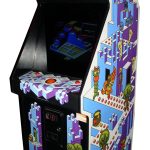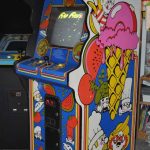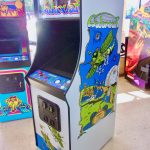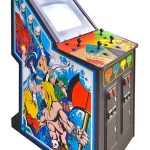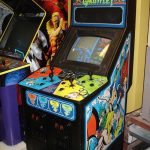Cabinet design played a crucial role in the success and appeal of early arcade games, influencing both gameplay and the player experience. Here are some key reasons why cabinet design was important:
1. Attracting Players
Early arcade games were competing for attention in noisy, brightly lit arcades. Eye-catching cabinet designs were crucial for drawing in potential players. Bold colors, stylized artwork, and themed graphics helped games stand out from the competition. For example, Pac-Man’s iconic yellow cabinet with its colorful artwork immediately distinguished it from other machines.
2. Branding and Iconography
Cabinets became a key part of a game’s identity, often reflecting the game’s theme or story. Games like Space Invaders or Donkey Kong had cabinets that reflected their space or adventure themes, respectively, adding to the overall atmosphere. This strong visual identity helped build memorable brands.
3. Physical Interaction
The physical layout of arcade cabinets directly influenced gameplay. The placement of buttons, joysticks, trackballs, and steering wheels was carefully designed for ergonomics and to enhance the player’s experience. Centipede used a trackball controller, and games like Pole Position featured steering wheels for racing. The feel and responsiveness of these controls added to player immersion.
4. Player Comfort and Accessibility
Arcade cabinets were designed to accommodate different heights and physical reaches, allowing for comfortable play for a variety of users, from children to adults. Adjustable chairs or stools were sometimes available, but standing play was common. Cabinets were designed to encourage short, quick sessions, making them accessible for casual players and competitive gamers alike.
5. Immersive Experience
Some cabinets were designed for a more immersive experience, going beyond just artwork. Games like Star Wars or After Burner used specialized designs with cockpit-style cabinets, wrapping the player in a themed environment and enhancing the illusion of being inside the game world.
6. Durability and Maintenance
Arcade machines were high-traffic, frequently used devices. Cabinets had to be durable and easy to maintain, given the constant wear from players. Solid construction was necessary to withstand heavy use, while being easy to repair or swap out parts like buttons or joysticks.
In short, cabinet design was integral to the visual appeal, functionality, and overall success of early arcade games, helping them thrive in a competitive environment and creating a more engaging experience for players.
Here’s a short list of our favorites and the artists that designed them…
- BURGER TIME by Kari Larson. (Data East, 1982)
- CENTIPEDE by Drew Suhre, (Atari, 1981)
- CRYSTAL CASTLES by Brad Chaboya (Atari, 1983)
- CRYSTAL CASTLES by Brad Chaboya (Atari, 1983)
- DIG DUG by Shinji Nakashima (Namco, 1982)
- FOOD FIGHT by Steve Hendricks (Atari, 1983)
- GALAXIAN (Midway, 1979)
- GAUNTLET by Deborah Short (Atari, 1985)
- GAUNTLET by Deborah Short (Atari, 1985)
- JOUST by Python Anghelo (Williams, 1982)
- JOUST by Python Anghelo (Williams, 1982)
- SPACE INVADERS by Rick Maurer (Taito, 1978)
- TAPPER by Paul Dyer (Bally Midway, 1983)
- TEMPEST by David Theurer (Atari, 1981)




